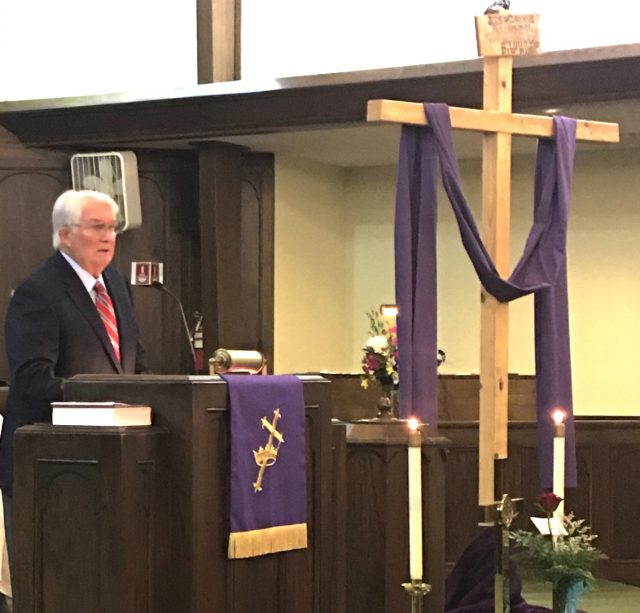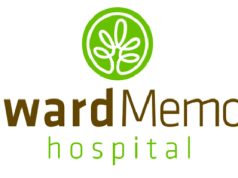(NEWS-LEADER note: Dr. John Hearnsberger spoke to First United Methodist Church, Sunday, on the subject of the virus. His comments are reprinted here by permission)
“Virtually everyone is aware of this viral outbreak from China just over 3 1/2 months ago. It is due to the coronavirus or COVID-19. It was recently declared a pandemic by the World Health Organization, and now declared a national emergency by President Trump last Friday afternoon. By the way, that was Friday the 13th. This pandemic has affected our economy, the global economy, restricted travel, closed schools, business, and canceled major sporting events, just to name a few. This virus is highly contagious.
Early this morning, I exchanged texts with Dr. David Blase. He was concerned about holding church services this morning and mentioned churches that were canceling services. My response, “I don’t know the answer, but we must be vigilant, practice good hygiene, pray, and not panic.” I also refer you to an article in today’s paper, “Coping with the coronavirus.” Section H1.
Everyone knows my expertise is surgery, not infectious disease. But I deal with infectious pathogens on a regular basis. I am not a germaphobe. I am not afraid of bacteria and viruses, including this virus. But I do have a healthy respect for all of them.
What I hope to accomplish this morning is to make you aware of some common, every day routines that could prevent you from contracting the virus or help the community contain the virus if it arrives.
Let’s define some terms:
Sporadic — when a disease occurs infrequently and irregularly. Example — tetanus or rabies.
Endemic — A constant presence and/or usual prevalence of a disease or infection within a geographical area. Eg. Lyme Disease.
Epidemic — A sudden increase in the number of cases — more that what is expected for the population in a given area. SARS was defined as an epidemic. MRSA is an epidemic. Opioid crisis, although non-infectious, is an epidemic.
Pandemic — An epidemic that has spread over several countries or continents, affecting large numbers of people.
So, let’s put this coronavirus out-break in CURRENT perspective — I say current because the data re this virus changes daily.
The current 2019-20 seasonal flu [CDC data] has already claimed an estimated 18,000 lives and hospitalized 310,000 patients.
The 2017-18 seasonal flu, 61,000 in the US died and 45 million were infected.
The Spanish Flu pandemic of 1918 infected an estimated 500 million people world-wide, killing an estimated 50 million people, including 675,000 Americans.
The H1N1 Swine Flu pandemic of 2009-10 hospitalized 274,000 and caused the death of 12,469 patients in the US. World-wide over 152,000 are believed to have died.
What’s going to happen with this coronavirus — COVID-19 == this virus for which we have no cure and no vaccine. A virus for which we have no treatment, such as Tamiflu. And tests for the virus are limited, although they should become rapidly available in the next week or two.
Will this be the next Spanish Flu? Or will it simply run its course and fade away in the next few months? The answer — WE DON’T KNOW! And it is this — THE FEAR OF THE UNKNOWN—that has us all to be so concerned.
A bit of positive news this morning from the — “China seems to have turned the corner and bigger cities are showing cautious optimism. [China] is seeing a slow but definite bounce back.”
The latest facts I could find on the coronavirus are:
1. Currently documented in 47/48 continental states and the District of Columbia. West Virginia is the only state without a case to date.
2. 12 cases in Arkansas, all in central Arkansas. No deaths.
3. Over 162,000 cases in the US. 60 deaths in the US. Over 6000 deaths world-wide. These numbers can change throughout the day. Seasonal flu death rates appear to be about 0.1%. Death from the coronavirus appears to be at least 10 times greater than seasonal flu, and estimates range from 1% to 3.4%. The takeaway is that you are highly likely to survive this infection unless you are elderly and debilitated.
4. Symptoms may appear 2-14 days after exposure.
5. Symptoms vary in severity, and many symptoms are mild.
6. Common symptoms — fever ,cough, shortness of breath — may range form very mild, cold-like symptoms, to difficulty breathing, persistent chest pain or pressure, confusion or inability to arouse, and cyanosis or blue lips.
So here is a disease no one knows the scope or severity, and we can’t treat or cure. So what is the take home message — PREVENTION! CONTAINMENT!
You, as individuals, must take the necessary steps to avoid getting this virus. If it comes to our community, we all need to work together to prevent its spread.
The following are guidelines from the CDC. They are likely to be updated. And they are appropriate for any infectious disease. I encourage you to follow these recommendations to protect you and your family from COVID-19.
1. Wash your hands frequently with soap and water. This is the time tested, time honored method to reduce the transmission of infectious disease.
2. If soap and water are not readily available, use a hand sanitizer with at least 60% alcohol.
3. Avoid touching your nose, mouth, and eyes with unwashed hands. Think about it—HOW MANY TIMES IN AN HOUR OR IN A DAY DO YOUR HANDS GO TO YOUR FACE! OFTEN UNCONSCIOUSLY! ARE THEY CLEAN?
4. Avoid close contact with anyone who is sick. Distance yourself from other people if the virus becomes present in our community. This is especially important for those at risk for becoming very ill—the elderly, debilitated, and immuno-compromised patients. The average age of death is reported to be 81y/o.
5. Stay home if you are sick.
6. Cover coughs and sneezes. Then wash or sanitize your hands.
7. Clean and disinfect frequently touched surfaces daily.
8. Work from home if possible.
IF YOU BECOME SICK—
1. Stay home and avoid public areas. Isolate yourself as much as possible. Wear a mask.
2. Call — DON’T GO TO — your primary care physician, Howard Memorial Hospital, the local health department, or the Arkansas Department of Health, and tell them you may have been in contact with or contracted the coronavirus.
3. Answer their questions and follow their recommendations.
4. SEEK MEDICAL ATTENTION IF YOUR CONDITION WORSENS!
The best websites to gain more information are the CDC, the Ark. Department of Health, and, as of Friday afternoon, President Trump announced that Google has developed a web site for the coronavirus and testing. I’m not telling you not to listen to the daily news and social media. There is an “infodemic” [new term for me] of bad information, especially prevalent on social media, so be aware. To learn the facts from health care professionals re the coronavirus, use these web sites.
So —
I want you to think — to be aware. Use common sense re EVERYONE and EVERY THING with which you come into contact. Don’t panic. Don’t believe rumors and all the hype.
A few simple examples of how to avoid this virus or any contagium. And I practice these myself.
1. Use your own pen to sign receipts. How many people have touched that other pen in the last 6 hours? That pen the waitress or store clerk hands you.
2. Quit shaking hands. Fist bump. Elbow bump.
3. My wife Gail pulls down the sleeve of her sweater or coat to open a door.
4. Use those sanitizing wipes provided by Walmart and other vendors to wipe down the cart handle.
5. Cover your coughs and sneezes.
6. Don’t forget to wash or sanitize your hands after touching ANYTHING the public touches — As door knobs, counter tops, hand rails, and gas pumps, to name a few.
- Be especially careful where large groups are gathered. Schools, gyms, churches, restaurants, businesses, grocery stores, etc. and extremely careful at large employers as Tyson, Husqvarna, and Weyerhaeuser.
- Limit all unnecessary visits — anywhere and everywhere.
THINK. DON’T PANIC. USE LOGIC AND REASON.
And as journalist Mike Masterson says as he ends each column, “Now go out into the world and treat everyone one you meet exactly how you’d like them to treat you.” Paraphrase of “Do unto others ….“








